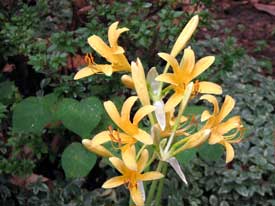Resource Library
Plant of the Week: Surprise Lily (Yellow)
The University of Arkansas System Division of Agriculture does not promote, support or recommend plants featured in "Plant of the Week." Please consult your local Extension office for plants suitable for your region.
Plant of the Week
Yellow Surprise Lily
Latin: Lycoris

I make an effort to know plant names, especially the ones that persist. Though this should be easy, it is harder than it looks. For a decade now I’ve had a surprise lily (Lycoris) blooming in my garden in early August that both delights and perplexes me. I love the plant, but wish I knew for sure what its name is.
Lycoris are long-lived, late summer- and fall-blooming bulbs that belong to the amaryllis family and hail from China, Japan and Korea. Only two species, the common pink Lycoris squamigera (surprise lily or naked lady) and the later-blooming, red-flowered L. radiate (spider lily or hurricane lily) are common in American gardens. These two species also possess the growth cycles of the 20 or so Lycoris species that have been named. Leaves of surprise lily emerge in early spring and die away by May, whereas the smaller spider lily sends up its leaves in October and they die away with the arrival of spring. Most of the winter-foliage species are less cold-hardy (zone 7 and south) while the spring-foliage types are more cold-hardy and will overwinter as far north as zone 5.
My yellow Lycoris is a spring-foliage type that grows in about the same configuration as the pink surprise lily. Plants get about 30 inches tall when they bloom in early August. During most years, the bloom periods for the pink and yellow form overlap. The foliage too is similar, with inch-wide leaves growing to about 18 inches long and dying away in early May.
I obtained my original bulb from Dr. Jim Waddick of Kansas City, Mo., a botanist with a keen interest in hardy bulbs who is perhaps best known for his book Iris of China (Timber Press, Portland, Ore. 1992). His trips to China to do field work during the early period of their reopening to the world introduced him to growers of Lycoris species that had never made it to the Western market. He began importing these and sporadically listed bulbs for sale.
Several possibilities present themselves as I try to learn this bulb’s true identity. Lycoris aurea, the golden spider lily, was quickly discounted because this species is a winter-foliage type and it seems only happy in zones 8 and 9. Lycoris chinensis seems a better fit because it is a spring-foliage type, but in photos it seems to have narrower petals (tepals). Work by USDA scientists, who used DNA analysis, and a Japanese researcher who did cytological work to look at lycoris chromosomes, indicates that this species is rather variable and some nursery trade material listed under this name may actually be of hybrid origins.
Pursuing the hybrid possibility, I’ve come up with two possibilities. One is a cross between Lycoris traubii x L. sanguinea made by Japanese breeder Kazuya Ohno Osumi in1962. Photos seem similar but the plant stature seems smaller. The other possibility is a hybrid Jim Waddick has named ‘Sunshine’. He speculates it may be a hybrid between the white-flowered L. longituba and L. chinensis. My plant has produced a seed pod and what looked like fertile seed, so this may call into question its hybrid origins because hybrids oftentimes don’t produce seed. But, I think I’ll call my cheery surprise lily ‘Sunshine’ anyway. It’s a nice, fitting name, even if it may be wrong.
Lycoris are bulbs that usually outlast the gardener, and I suspect ‘Sunshine’ will do the same with me. The bulbs resent being moved, and it is not unusual for them to skip flowering for a year or two after division. I even had one clump of bulbs skip a year of sending up leaves after a move, but then it came back and is now flowering. The best time to divide is in the early fall after flowering so that roots have a chance to become established over winter. I like to plant surprise lilies in a groundcover bed where their nakedness in bloom doesn’t look quite so stark.
By: Gerald Klingaman, retired
Extension Horticulturist - Ornamentals
Extension News - August 6, 2010
The University of Arkansas System Division of Agriculture does not maintain lists of retail outlets where these plants can be purchased. Please check your local nursery or other retail outlets to ask about the availability of these plants for your growing area.